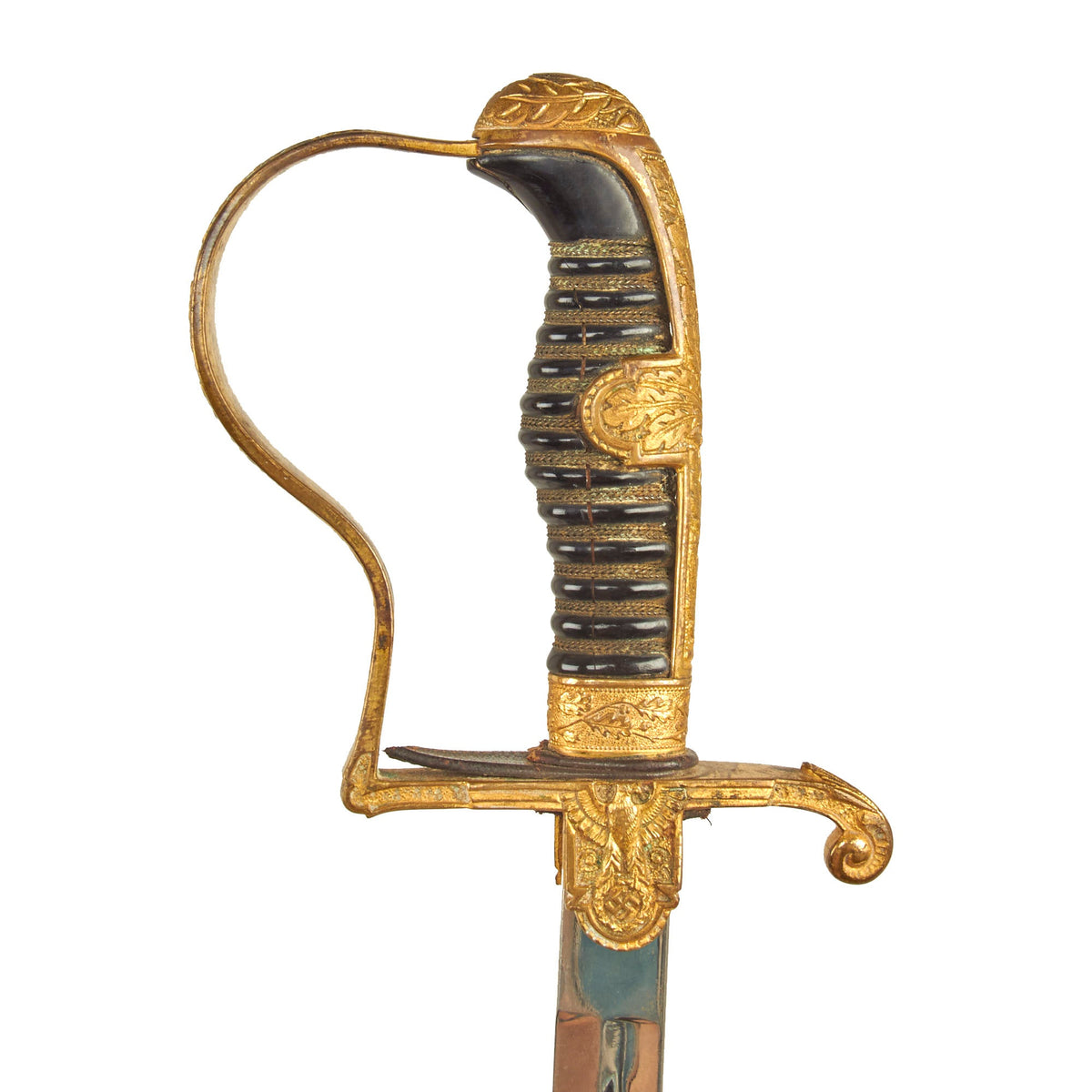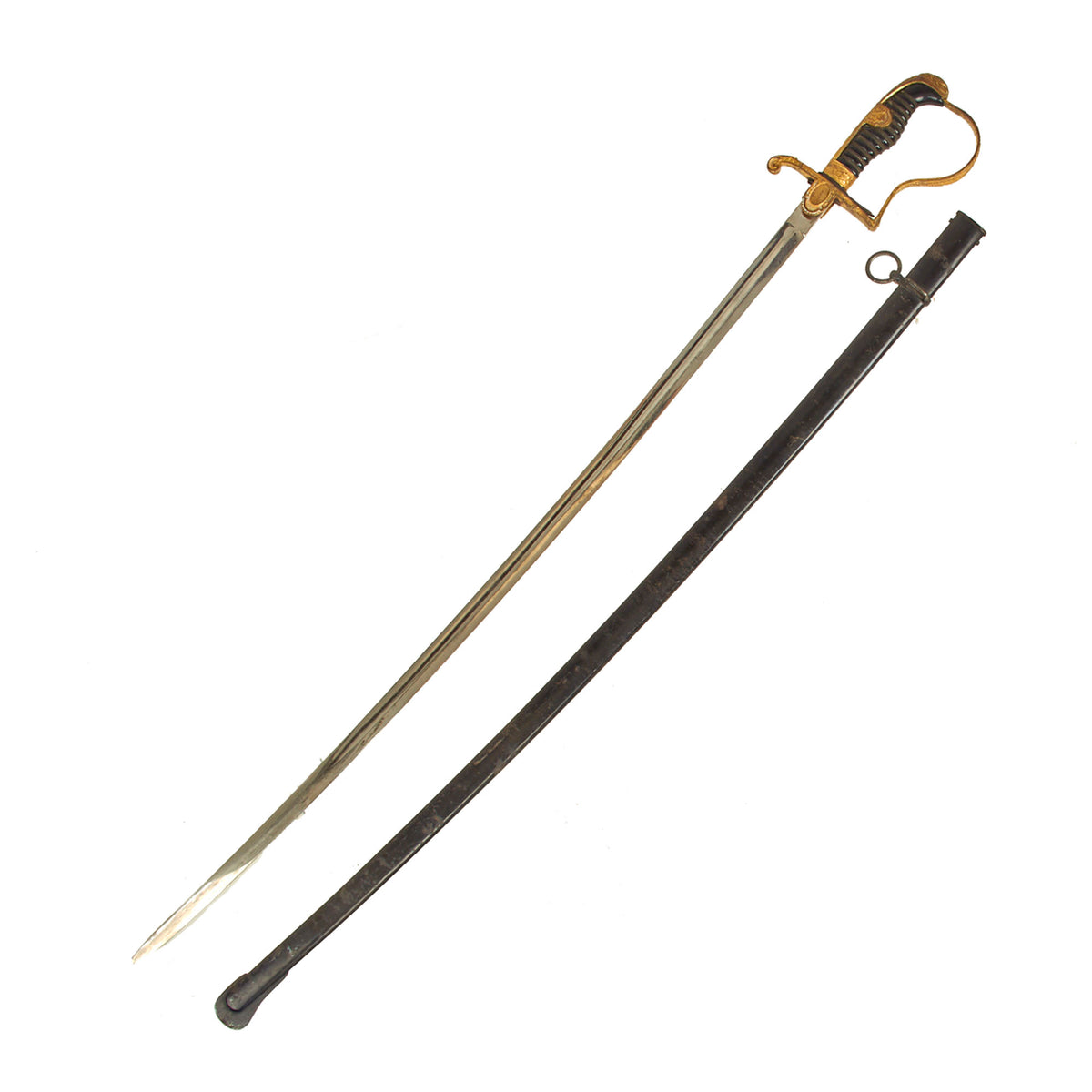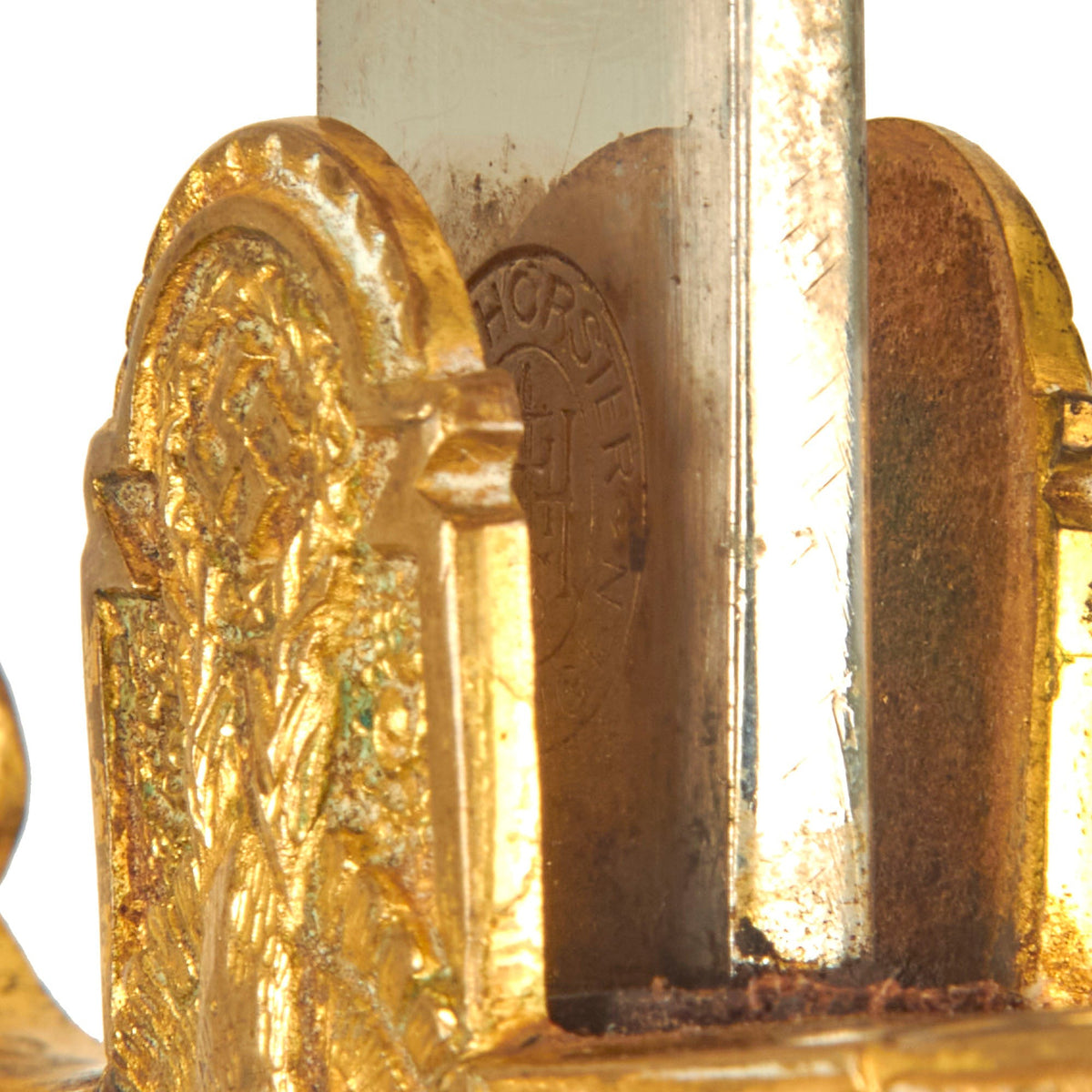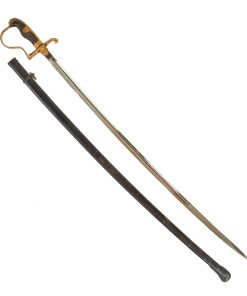Original German WWII Army Officer Dove Head Sword by E. & F. Hörster of Solingen with Steel Scabbard Original Items
$ 395,00 $ 118,50
Original Item: Only One Available. This Army Dove Head Sword is a very nice example, made by the firm E. & F. Hörster of Solingen, the legendary “City of Blades” in Western Germany. It features a very nice nickel plated blade, and comes complete with the correct steel scabbard.
The hilt on this example is the classic gilt brass alloy, not the later war plated aluminum. Unlike most we see, the gilding still looks to be over 60% intact, with just some light patination on the exposed brass where it has worn away. There also looks to be some residue from polishing in areas. The overall design is a bit of a departure from the other examples we have seen, which mostly take after the “Field Marshall” series of Carl Eickhorn. The dove head and backstrap are embossed with the classic German oak leaves and acorns motif, which extends onto the side tabs. The “flat” P guard has the same motif, as does the brass ferrule. There are lots of hand enhancing visible, especially on the cross guard area .
The chappe/langet features a raised out “spread wing” National eagle, which shows excellent detail to his beak, eye, breast feathering, wing feathering, talons and mobile clutched swas (hook cross). The other chappe is blank and would often be used for the officer to add a monogram, however this example is still unmarked.
The grip of this example is a black celluloid over a carved wood base, and originally had a leather finger loop at the top, which is still partly retained. The celluloid is still in good condition, though it has cracked open almost from the bottom to the top, caused by the material shrinking over time. The grip is wrapped with three pairs of twisted wire, with the center pair being larger, and the wrapping is fully intact. There is some dirt and oxidation around the wires, and they show a bit of oxidation. There is some play in the hilt, particularly with the back strap.
The nickel plated blade is 32 1/4 inches long, made of high quality spring steel. The plating is in very good condition, well retained overall but with some flaking and wear through, particularly on the left side of the blade. There is also speckled oxidation on the plating as well. The edge is still correctly unsharpened, and does not have any major dents or nicks that would suggest it was abused after capture. The original leather blade buffer is still present, showing some wear from age.
The ricasso of this blade is stamped with maker name E. & F. HÖRSTER / SOLINGEN in an oval “lozenge” around the company’s trademark downward pointing sword piercing interlocking HHS initials. E. & F. Hörster & Co Gmbh, is a well-known maker from Solingen, the famous “City of Blades” in Western Germany, which marketed many fine edged weapons. Originally founded in 1850 as “Friedrich Hörster” in 1850, the company was renamed to E. & F. Hörster in 1870 at the behest of Friedrich Emil & Fritz Hörster. The firm lasted long after WWII, finally being declared insolvent in 1996. For more information please see GERMAN KNIFE AND SWORD MAKERS by J. Anthony Carter. Unfortunately due to being covered by the rainguard / chappe, this is nearly impossible to photograph well.
The included scabbard is still in very good condition, and does not have any major dents or bends that we can detect in the steel body. The black enamel paint is still in good shape, however it definitely does show some light wear and oxidation from age. There is checking and crazing throughout, only possible due to years of age. The scabbard still retains the original hanger ring and flat loop to hook on the belt hanger.
Overall a lovely example of a German Army Officer Dove Head sword by a desirable maker, complete with scabbard. Ready to display!
Specifications:
Blade Length: 32 1/4″
Blade Style: Single Edge w/ Fuller
Overall length: 37 1/2“
Guard dimensions: 5″ width x 5” length
Scabbard length: 33 1/2”
The German Army (German: Heer, was the land forces component of the Wehrmacht, the German armed forces, from 1935 to 1945. The Wehrmacht also included the Kriegsmarine (Navy) and the Luftwaffe (Air Force). During World War II, a total of about 15 million soldiers served in the German Army, of whom about seven million became casualties. Separate from the army, the Waffen-SS (Armed SS) was a multi-ethnic and multi-national military force of the Third Reich. Growing from three regiments to over 38 divisions during World War II, it served alongside the army but was never formally part of it.
Only 17 months after AH announced publicly the rearmament program, the Army reached its projected goal of 36 divisions. During the autumn of 1937, two more corps were formed. In 1938, four additional corps were formed with the inclusion of the five divisions of the Austrian Army after the Anschluss in March. During the period of its expansion by Adolf AH, the German Army continued to develop concepts pioneered during World War I, combining ground (Heer) and air (Luftwaffe) assets into combined arms teams. Coupled with operational and tactical methods such as encirclements and the “battle of annihilation”, the German military managed quick victories in the two initial years of World War II, prompting the use of the word Blitzkrieg (literally lightning war, meaning lightning-fast war) for the techniques used.
The German Army entered the war with a majority of its infantry formations relying on the horse for transportation. The infantry remained foot soldiers throughout the war; artillery also remained primarily horse-drawn. The motorized formations received much attention in the world press in the opening years of the war, and were cited as the main reason for the success of the German invasions of Poland (September 1939), Norway and Denmark (April 1940), Belgium, France and Netherlands (May 1940), Yugoslavia (April 1941) and the early campaigns in the Soviet Union (June 1941). However their motorized and tank formations accounted for only 20% of the Heer’s capacity at their peak strength.
Fast Shipping with Professional Packaging
Thanks to our longstanding association with UPS FedEx DHL, and other major international carriers, we are able to provide a range of shipping options. Our warehouse staff is expertly trained and will wrap your products according to our exact and precise specifications. Prior to shipping, your goods will be thoroughly examined and securely secured. We ship to thousands clients each day across multiple countries. This shows how we're dedicated to be the largest retailer on the internet. Warehouses and distribution centres can be located throughout Europe as well as the USA.
Note: Orders with more than one item will be assigned a processing date depending on the item.
Before shipping before shipping, we'll conduct a thorough inspection of the items you have ordered. Today, the majority of orders will be delivered within 48 hours. The delivery time will be between 3-7 days.
Returns
The stock is dynamic and we cannot completely manage it because multiple stakeholders are involved, including our factory and warehouse. So the actual stock may alter at any time. It's possible that you may not receive your order once the order has been made.
Our policy is valid for a period of 30 days. If you don't receive the product within 30 days, we are not able to issue a refund or an exchange.
You can only return an item if it is unused and in the same state as the day you received it. You must have the item in its original packaging.
Related products
Uncategorized
Uncategorized
Armored Burgonet Helmet & Polearm from Scottish Castle Leith Hall Circa 1700 Original Items
Uncategorized
Uncategorized
Uncategorized
Uncategorized
Band of Brothers ORIGINAL GERMAN WWII Le. F.H. 18 10.5cm ARTILLERY PIECE Original Items
Uncategorized
Uncategorized
Uncategorized
Uncategorized
Uncategorized
Uncategorized
Uncategorized
Uncategorized
Uncategorized
Uncategorized
Uncategorized
Angolan Rebel 1970s era 60mm Inert Display Mortar from Angolan Civil War Original Items
Uncategorized
Australian WWII Owen MK1 Machine Carbine SMG Custom Fabricated Replica with Sling Original Items
Uncategorized
Uncategorized













































































